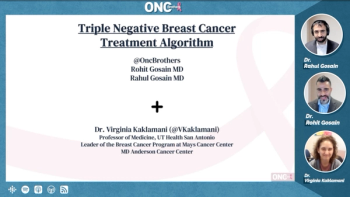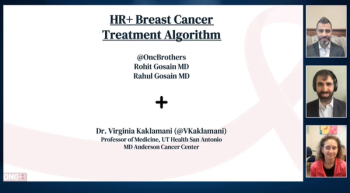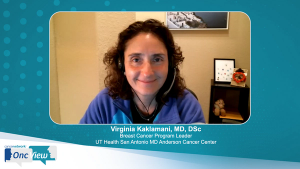
Virginia Kaklamani, MD, DSc
Articles by Virginia Kaklamani, MD, DSc


TPS 28 ELEGANT: Elacestrant VS Standard Endocrine Therapy in Women and Men With Node-Positive, Estrogen Receptor-Positive, HER2-Negative, Early Breast Cancer With High Risk of Recurrence in a Global, Multicenter, Randomized, Open-Label Phase 3 Study


86 Elacestrant Combinations in Patients With Estrogen Receptor-Positive, HER2-Negative Locally Advanced or Metastatic Breast Cancer: Update From ELEVATE, a Phase 1b/2, Open-Label, Umbrella Study

87 Elacestrant Plus Abemaciclib Combination in Patients With Estrogen Receptor-positive, HER2-Negative Advanced or Metastatic Breast Cancer

Panelists discuss how sacituzumab shows significant efficacy in triple-negative breast cancer, with improved progression-free and overall survival. It demonstrates particular benefit in pretreated patients and brain metastases cases. Trastuzumab deruxtecan (T-DXd) excels in HER2-positive breast cancer treatment, showing remarkable response rates and survival benefits, including in patients with brain metastases and those who progressed on prior therapies.

Panelists discuss how the approach to metastatic disease focuses on systemic therapy, as cancer has spread beyond its primary site. Treatment typically combines targeted therapy, immunotherapy, chemotherapy, and/or hormonal therapy based on cancer type and molecular profile. Goals shift toward extending survival, controlling symptoms, and maintaining quality of life rather than cure. Regular monitoring of treatment response and adverse effects guides ongoing care decisions.

Panelists discusses how triple-negative breast cancer (TNBC) treatment toxicities require careful monitoring and management. Common adverse effects include fatigue, nausea, hair loss, neuropathy from chemotherapy, and radiation-induced skin changes. Health care teams employ preventive strategies, dose modifications, and supportive care to minimize complications while maintaining treatment efficacy.

Panelists discuss how locally advanced triple-negative breast cancer (LATNBC) is an aggressive breast cancer subtype characterized by absence of estrogen receptor, progesterone receptor, and HER2 protein expression. It presents with large tumors and/or extensive lymph node involvement without distant metastasis. Treatment typically involves neoadjuvant chemotherapy followed by surgery and radiation.

Panelists discuss how triple-negative breast cancer (TNBC) is an aggressive form of breast cancer characterized by the absence of 3 key receptors: estrogen receptor, progesterone receptor, and HER2 protein. TNBC tends to grow and spread faster than other breast cancer types, presenting unique treatment challenges since common targeted therapies like hormone therapy and HER2-targeted treatments are ineffective. Standard treatment primarily relies on chemotherapy, surgery, and radiation.

Panelists discuss ongoing clinical trials and how the treatment landscape for HR positive (HR+)/ HER2 negative (HER2-) breast cancer is evolving with novel targeted therapies and combination strategies, with Dr Isaacs highlighting the most exciting aspects of these trials and their potential impact on the future of precision medicine in this patient population.

Panelists discuss how the evolving treatment landscape, particularly with the introduction of new agents, has influenced Ms. Diaz's approach to patient education, highlighting strategies for staying informed and proactive, as well as ensuring effective coordination of care across multidisciplinary teams to optimize patient outcomes.

Panelists discuss strategies for patient education and monitoring hyperglycemia with PI3K inhibitors, including pre-treatment screening, baseline assessments, early recognition of adverse events, and supportive care measures such as dietary modifications, with Ms. Harrington sharing practical approaches and helpful resources; Dr Isaacs comments on potential differences in adverse event management, particularly hyperglycemia, between inavolisib, capivasertib, and alpelisib, offering practical advice for oncologists; and Dr Kaklamani explores how the varying safety profiles of these agents may influence treatment selection and sequencing, including the potential for inavolisib to become standard of care in the first-line PIK3CA-mutant setting and how this will affect PI3K inhibitor sequencing in later treatment lines.

Panelists discuss the key safety findings from the INAVO120 trial involving the inavolisib combination, highlighting aspects of its safety profile and how it compares with the safety data and clinical experience with other PI3K pathway inhibitors, noting any unique or notable differences.

Panelists discuss the prevalence of PIK3CA mutations in HR positive (HR+)/ HER2 negative (HER2-) breast cancer, their prognostic implications, and the critical role of identifying these mutations for personalized treatment planning, while Ms. Harrington shares insights on common patient questions about biomarker testing, the importance of molecular testing, and educational resources for helping patients understand their test results; Dr Kaklamani addresses how the approval of inavolisib may prompt routine PIK3CA mutation testing in the frontline setting, and Dr Isaacs and Ms. Diaz discuss the infrastructure changes needed in community practices to support this shift and the lessons learned from evolving biomarker testing practices.

Panelists discuss the prevalence of PIK3CA mutations in HR positive (HR+)/ HER2 negative (HER2-) breast cancer, their prognostic implications, and the critical role of identifying these mutations for personalized treatment planning, while Ms. Harrington shares insights on common patient questions about biomarker testing, the importance of molecular testing, and educational resources for helping patients understand their test results; Dr Kaklamani addresses how the approval of inavolisib may prompt routine PIK3CA mutation testing in the frontline setting, and Dr Isaacs and Ms. Diaz discuss the infrastructure changes needed in community practices to support this shift and the lessons learned from evolving biomarker testing practices.

Panelists discuss how the introduction of oral targeted therapies has transformed the patient experience by offering actionable treatment options for identifiable mutations, influencing prognosis and treatment discussions, and altering the nature of initial patient conversations, while Dr Isaacs highlights key efficacy and safety data from the INAVO120 trial and the implications of inavolisib’s PI3Kα-specific mechanism, and Dr Kaklamani addresses the evolving rationale for targeting truncal mutations earlier in treatment, emphasizing the role of combination therapies in first-line settings and trials such as ELEVATE/ELECTRA and CAPItello-292.

Panelists discuss how the October 2024 FDA approval of inavolisib in combination with palbociclib and fulvestrant for HR positive (HR+)/ HER2 negative (HER2-) metastatic breast cancer with a PIK3CA mutation marks a pivotal advancement in precision medicine, highlighting how agents like such as inavolisib, capivasertib, elacestrant, and alpelisib have transformed treatment approaches and expanded therapeutic options for patients.

Panelists discuss how emerging targeted therapies, including novel PI3K inhibitors and combination treatments, are advancing precision pathways in HR positive (HR+)/HER2 negative (HER2-) breast cancer, offering new hope for personalized treatment and improved patient outcomes.



Virginia Kaklamani, MD, offers clinical insights on treatment toxicity considerations in HR+ breast cancer, and the Oncology Brothers outline key takeaways from the discussion.

Medical oncologists provide comprehensive insights on the standard-of-care treatment practices for patients with advanced/metastatic HR+ breast cancer.

The Oncology Brothers and Virginia Kaklamani, MD, outline the treatment algorithm for patients with locally advanced HR+ breast cancer.

Virginia Kaklamani, MD, joins Rohit Gosain, MD, and Rahul Gosain, MD, to discuss treatment paradigms for patients with early-stage HR+ breast cancer, highlighting the differences in treatment for premenopausal and postmenopausal patients.




The panel closes their discussion by musing on the future of HER2 mBC treatments.

A discussion on the prevalence and treatment difficulties of leptomeningeal metastases in HER2+ mBC.
Latest Updated Articles
 Case Presentation: A 60-Year-Old Woman with HER2+ mBC with Brain Metastases
Case Presentation: A 60-Year-Old Woman with HER2+ mBC with Brain MetastasesPublished: December 22nd 2022 | Updated:
 Leptomeningeal Metastases in HER2+ mBC
Leptomeningeal Metastases in HER2+ mBCPublished: January 6th 2023 | Updated:
 Systemic Therapy Before Whole Brain Radiation for HER2+ mBC with Brain Metastases
Systemic Therapy Before Whole Brain Radiation for HER2+ mBC with Brain MetastasesPublished: January 6th 2023 | Updated:
 Screening for Brain Metastases in HER2+ Breast Cancer
Screening for Brain Metastases in HER2+ Breast CancerPublished: December 15th 2022 | Updated:
 Managing Adverse Events of Tucatinib in Patients with HER2+ mBC with Brain Metastases
Managing Adverse Events of Tucatinib in Patients with HER2+ mBC with Brain MetastasesPublished: January 6th 2023 | Updated:
 HER2+ Breast Cancer and the Role of Maintenance Therapies
HER2+ Breast Cancer and the Role of Maintenance TherapiesPublished: February 8th 2022 | Updated:


